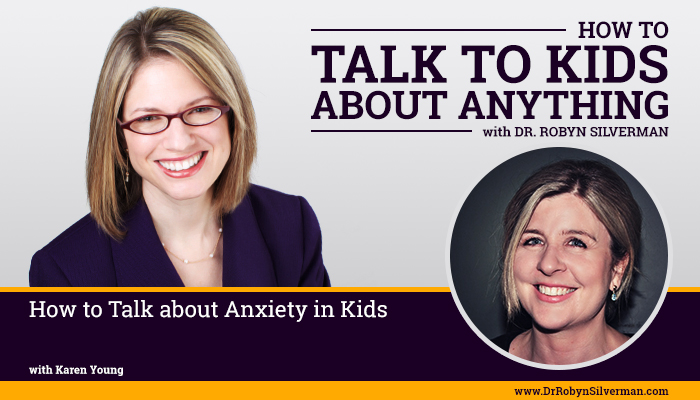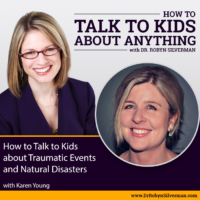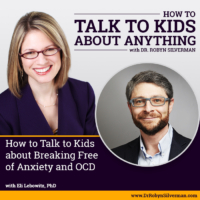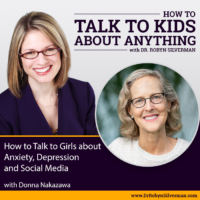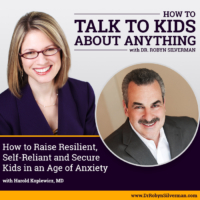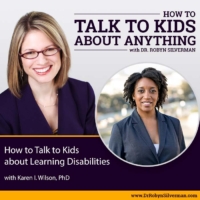Podcast: Play in new window | Download
Subscribe: Apple Podcasts | RSS | More
How to Talk about Anxiety in Kids
This podcast will focus on how to talk to kids about anxiety and how to give them the knowledge of what is happening in their bodies when anxiety takes hold. It is through giving them the information and strategies, that they become the boss of their brains and in charge of their own anxiety.
All kids gets anxious about something. In fact, anxiety is a normal response to something dangerous or stressful. We’ve talked about anxiety in the past —and in particular, fear, with Dr. Andrea Umbuck as well as how to outsmart worry with Dr. Dawn Huebner. Anxiety, itself becomes problematic when it prevents us from doing the activities we love and the normal, everyday activities we have to do. Anxiety can show up without warning– get into our heads and govern how we think, feel and act. And as you can imagine—or you may know first hand- anxiety can feel terrible and as a parent, teacher or coach watching it take hold of a child—it can be confusing to know what to do, what to say and how to help a child get through it.
To help is know how to handle anxiety in children, I am delighted to be interviewing Karen Young.
Karen Young has worked as a psychologist in private practice and in educational settings. She founded the popular website, Hey Sigmund, which attracts millions of readers each year. Karen is a sought-after speaker, both at home in Australia and internationally. She is the author of ‘Hey Warrior’, a book for kids to help them understand anxiety and find their ‘brave’. The book has now been translated into a number of languages—and we couldn’t be more thrilled to welcome her to How to Talk to Kids about Anything
The podcast provides:
- Why does anxiety happen in children?
- What do children need to know about anxiety?
- How can we scaffold children and help them cope with anxiety?
- How might we see anxiety showing itself in children?
- What should adults do and not do to help kids?
- What kinds of exercises can children do to help quiet the brain when anxiety strikes?
Important Messages:
- Kids can practice mindfulness to help them with anxiety
- Anxiety can show itself in covert ways.
- Help your children understand why they must practice mindfulness and breathe
- Loving parents can sometimes do things that support anxiety inadvertently. For example, support avoidance.
- Anxiety can generalize which can cause problems.
- Kids feel like they are the only one and that they seem like a freak. They feel like they don’t have someone to talk to or the person who they did talk to told them to just deal with it. Of course, a lot of adults don’t know what to do and say (which is why we are doing this podcast!)
- Back when we were cave people, the capacity to detect threat would have kept everybody safe. The difference now is that back then, the threats were physical—the anxiety response was there when there was a need for fight or flight. Now, the threats are more psychological—humiliation, embarrassment, separation and loss—all things we struggle with as humans—it can go boom for people with anxiety and cause trouble. Your body is gearing itself up for action but no action is needed.
- Anxiety can look like physical symptoms—stomachaches, head aches, etc. It can look like avoidance- “I don’t want to go to the party, school, soccer.” Or- “I’m going to the library during lunch.” It can look like perfectionism as well—because they want to avoid the consequences of not being perfect. It can also look like aggression.
- Anxiety can also look like bursting into tears (and they may not know why)\
- Worrying thoughts are a sign of anxiety
- Butterflies, rosy cheeks, tense muscles, stomach aches.
- Class clown can be the work of anxiety (to distract from anxiety).
- Don’t treat the anxiety as bad behavior because it will just make the anxiety worse. It can stop it in the moment but not in the long term.
- When our children are overwhelmed with anxiety, our prefrontal cortex goes offline.
- Be accessible but you can give your children the space they need.
- Underscore that you understand why they are frustrated, validate their feelings but set boundaries on what’s OK in terms of behavior and then you can discuss strategies.
- Practice mindfulness and how to handle the anger.
- Give your children the information that drives anxiety- when your brain senses that there is a threat, there is a part of your brain that is called the amygdala that tries to protect you. It can surge you with a neurochemical that makes you feel like you need to fight or take flight. But you need to be the boss of it. When it’s a real threat, this is great. When it’s a safe thing- it shuts down your thinking brain so you can refrain from thinking about the consequences. You have to be the boss of your brain. It’s really smart but it can read things wrong sometimes.
- Short breaths are a physical response to keep a reserve of oxygen in case you need to send it to the muscles to fight. When we breathe, we send the message to our brain that we are in charge now.
- What’s your first clue when you start to get angry? Help them learn to sense the signs.
- Mindfulness expands the space- you can have a thought before you react. YOU stay powerful. You stay in charge of the amygdala. Mindfulness trains the brain to stay in the present.
- You need to tell your brain that you are the boss—because their brains are so good at telling them that things will go wrong.
- Talk about their history—and how they successfully dealt with things in the past.
- Physical activity is a great way to deal with anxiety.
- When children know that anxiety is happening to them because their brain thinks; “there is something that it needs to protect me from” and is filling them up with “special body fuel to get me ready to fight or flight. I don’t need to fight or flee so it’s building up.” Also- “the reason why I have a racy heart is not because something bad is about to happen (or I’m about to have a heart attack) but because my heart is pumping to get that fuel around my body. The reason my legs and arms feel tight isn’t because something bad is about to happen (or because I’m sick) but because my brain is making my arms ready in case I need to fight and my legs ready in case I need to flee.” For survival, when we have anxiety, anything that is not essential for survival shuts down—and one of those non-essential systems is digestion. So they might feel like they’re going to vomit. If they understand where the symptoms are coming from then what we say is; “what’s happening is understandable and it’s normal. But now that you know this, you need to be the boss of your brain when you know there isn’t any real reason to fight or flee. You can do deep breaths to help stop those feelings and those thoughts.”
Notable Quotables:
- “Anxiety is there to protect us. It feels bad but it’s there to look after us. We just need it not to be there when we don’t need it.”
- “The vulnerability towards anxiety was always there. Parents don’t cause it.”
- “We need to let children know that anxiety means that your body is doing exactly what strong healthy brains need to do—which is to keep you safe. It’s just happening a bit too often and a bit too much when you don’t need protecting.”
- “Anxiety can sometimes look like perfectionism. It’s not because kids feel the need to be perfect but rather to avoid the consequences of now being perfect.”
- “When a child is overwhelmed with emotion, we just need to ride the wave with them.”
- “Anxiety can look like aggression. It’s important that we don’t treat the anxiety as bad behavior because that will only make the anxiety worse and the response worse.”
- “You lose power when you use high emotion in a bad way. People can’t hear you and they won’t listen to you.”
- “Naming the emotion soothes the nervous system.”
- “When we take bad behavior personally, that shame can shut down an effective response and it stops us seeing our children as their own people.”
- “We maximize our influence through connection.”
- “You need to be the boss of your brain. Your brain is really smart but it sometimes reads things wrong. It can see things as a threat when it’s not a threat.”
- “Sometimes things are worth the risk because that’s how you train your brain to do brave things.”
- “When going through the anxiety, the feelings and thoughts feel real.”
- Tell your kids; “I know you are brave enough.”
- “The best thing to do when we feel anxiety is to breathe. Strong deep breaths are like a lullaby to your amygdala. It will bring your thinking brain back online—unlocking it so it can do what it needs to do.”
- “When it comes to anxiety and mental blocks, kids really need information because the more they lock up the more anxious they get and the more they lock up.”
- “An anxious brain is a very busy brain so breathing needs to be practiced outside of anxiety so it can become a more automatic response.”
Resources:
- HeySigmund.com
- Hey Warrior (Kids’ book)
- Anxiety and kids: How to Turn it Around

